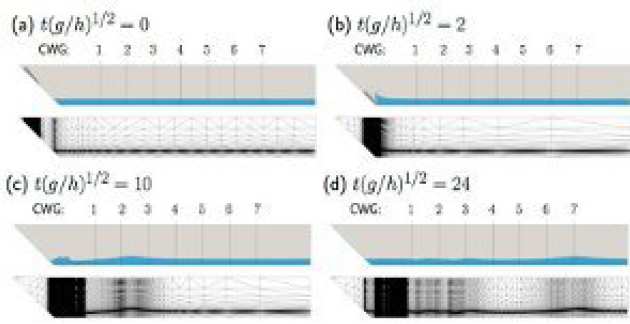Examples of current research collaboration projects
Examples of current research collaboration projects:
Numerical Methods for Modelling Multi-Material Compressible and Multi-Phase Flows on Unstructured Adaptive Meshes
Applied Modelling and Computation Group, Department of Earth Sciences and Engineering, Imperial College London
 This project aims to develop advanced numerical methods for the simulation of highly dynamic multi-scale, multi-material and multi-phase flows in complex domains, based on the finite element model fluidity.
This project aims to develop advanced numerical methods for the simulation of highly dynamic multi-scale, multi-material and multi-phase flows in complex domains, based on the finite element model fluidity.
Four timeframes showing the water (upper, blue), landslide (upper, grey) and adaptive columnar mesh (lower), from the numerical simulation of a landslide-generated tsunami on an adaptive columnar mesh with a hydrostatic pressure. Time after the landslide impacted with the water, t, is non-dimensionalised by the gravitational acceleration and the experimental water depth, h=0.3m.
Image credits: NASA/visible earth
Blast Force Protection, Centre for Blast Injury Studies
Imperial Blast Biomechanics and Biophysics Group
 This theme is led by Dr William G Proud and deals with the interaction of the blast wave with the materials and structures around the human body. It is essential that the stress pulses applied to biological materials are representative of those experienced in the real world environment. A number of laboratory-based techniques have thus been developed to control and vary the loads put on biological, clothing and protection materials. The overall aim is to define the limits of endurance of the human body to blast loading and impact. This can be used to understand the threat levels to different limbs, organs and tissues.
This theme is led by Dr William G Proud and deals with the interaction of the blast wave with the materials and structures around the human body. It is essential that the stress pulses applied to biological materials are representative of those experienced in the real world environment. A number of laboratory-based techniques have thus been developed to control and vary the loads put on biological, clothing and protection materials. The overall aim is to define the limits of endurance of the human body to blast loading and impact. This can be used to understand the threat levels to different limbs, organs and tissues.
See also: Centre for Blast Injury Studies
Image credit: courtesy of Schwartz (2009)
Hysteresis in the Elastic-plastic Compression-unloading Cycle
Institute of Problems of Chemical Physics and Joint Institute for High Temperatures, Russian Academy of Sciences
This collaborative project recently investigated the influence of stress relaxation kinetics on the peak state achieved during impact loading. Samples ranging in thickness from 5 mm down to 200 microns were shocked using the ISP’s 100 mm light gas launcher. The experiments demonstrated a clear relationship between the thickness of the target and the peak elastic state in agreement with previous observations for magnesium.



